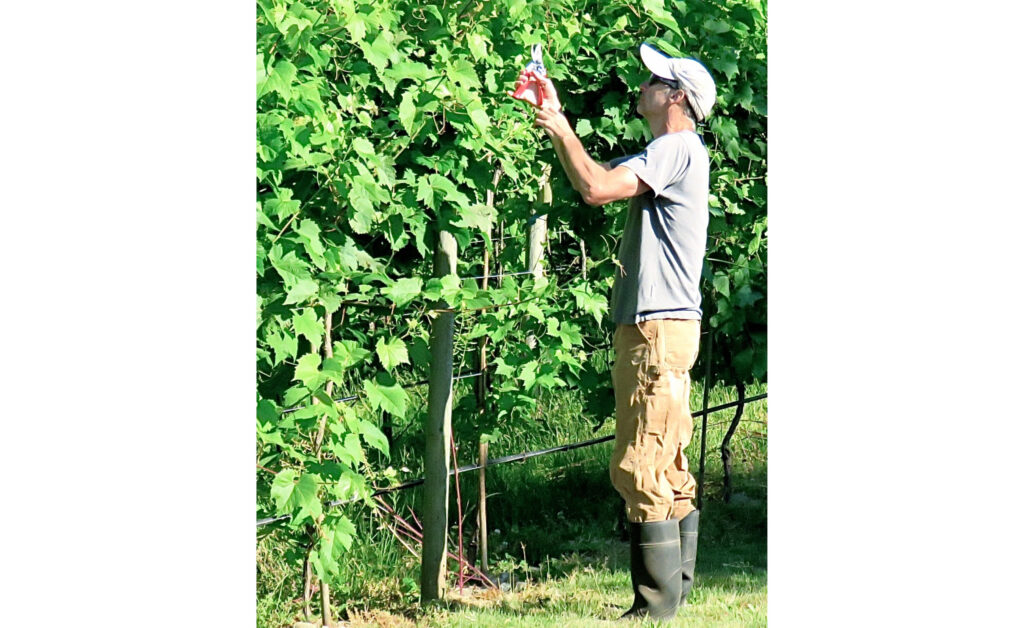by Tilar J. Mazzeo | photo by Nish Gera –
With spring here, you all can handle an industry update, right? I try to keep things upbeat, but this month’s column takes a hard look at why running a winery on the Saanich Peninsula is so darned challenging – and what we can do about it.
The Peninsula can produce world-class wines. Sparkling wines, in particular, have huge potential. Look at what they’ve done in the south of England!
Some mistakes were made in the early days. A lot of Marechal Foch was put in, and frankly it’s just not a fine-wine varietal. There was also a lot of Ortega planted, and it makes me want to cry. The varietal is thin skinned and, as a result, too prone to powdery mildew, which on the Peninsula is our biggest challenge. We nicknamed our Ortega planting “Heartbreak Ridge.”
Now that we have phylloxera (an insect pest) on the Peninsula, replanting many of the first-generation vineyards is going to be necessary if we’re going to carry on, and maybe that will be a good thing – as long as vineyards are actually replanted. That is uncertain.
We’re always going to be an area of small, discontinuous vineyards, as well. There is A-grade vineyard land on the Saanich Peninsula, but it tends to be in pockets. We are not going to have 40-acre vineyards planted on valley floors. Some of the best vineyards locally are less than an acre, they are almost all on slopes, and many winemakers farm or source from as many as a half-dozen different properties, but the provincial legislation wasn’t written for small-scale farming.
British Columbia ties land-based winery licensing to just one thing: quantity. The volume of wine produced must be at least 4,500 litres per year. The vineyard size must be at least two acres at the primary location to be allowed to have a farm-gate tasting room.
These minimums obviously create some barriers to entry that in the middle of an intergenerational asset-inflation crisis we should probably be talking about. I’ll leave that to the economists and just observe that not letting winemakers build a brand up from the ground and grow production as demand increases does effectively shut out a lot of young, talented farmers and winemakers. There is a reason small, land-based wineries tend to be retirement projects.
But for me the real absurdity of the current legislation is that it creates perverse incentives, including the incentive to avoid sustainable farming practices.
How? Let’s run some numbers. If you’re trying to make a good-quality wine with small-scale equipment, you need eight to 10 tonnes of typical fruit to make 4,500 litres.
How many acres of vineyard is that? Well, it depends, of course, on how densely you’re planted and to what varietal. But yields otherwise depend on farming practices. Chemical practices can comfortably get five tonnes an acre. Five tonnes an acre, times two acres, equals 10 tonnes, equals 500 cases. I have a sinking feeling this is how the legislation was written.
If you want to farm that vineyard using the carbon-sequestration and regenerative soil-building practices that we hear so much about being the climate-change priority, two tonnes an acre – and increased soil health – would be a good outcome.
Lower-yielding vineyards also generally produce higher-quality wine, so this should be a win-win. But, because you must produce a certain quantity of wine, with no consideration for the quality of your wine, your price point or your farming practices, sustainable viticulture – the thing we say we want to encourage – is disadvantaged.
It also holds back winemaking. I know of a local pocket vineyard that tends naturally toward Botrytis Cinerea – the “noble rot” that desiccates grapes on the vine and is used to make Sauternes. The vineyard is capable of producing a high-quality dessert wine or a nice, average table wine.
The problem? Raisins do not have a lot of water. Where volume matters, table wine is the only sensible option.
What would better, small farming-friendly legislation look like? It would start by counting – if bean-counting is a must – the number of grapevines a viticulturist farms, not the number of acres or the volume of extraction. That would be a genuinely level playing field for sustainable farmers and would allow local winemakers to focus on quality, not quantity.




